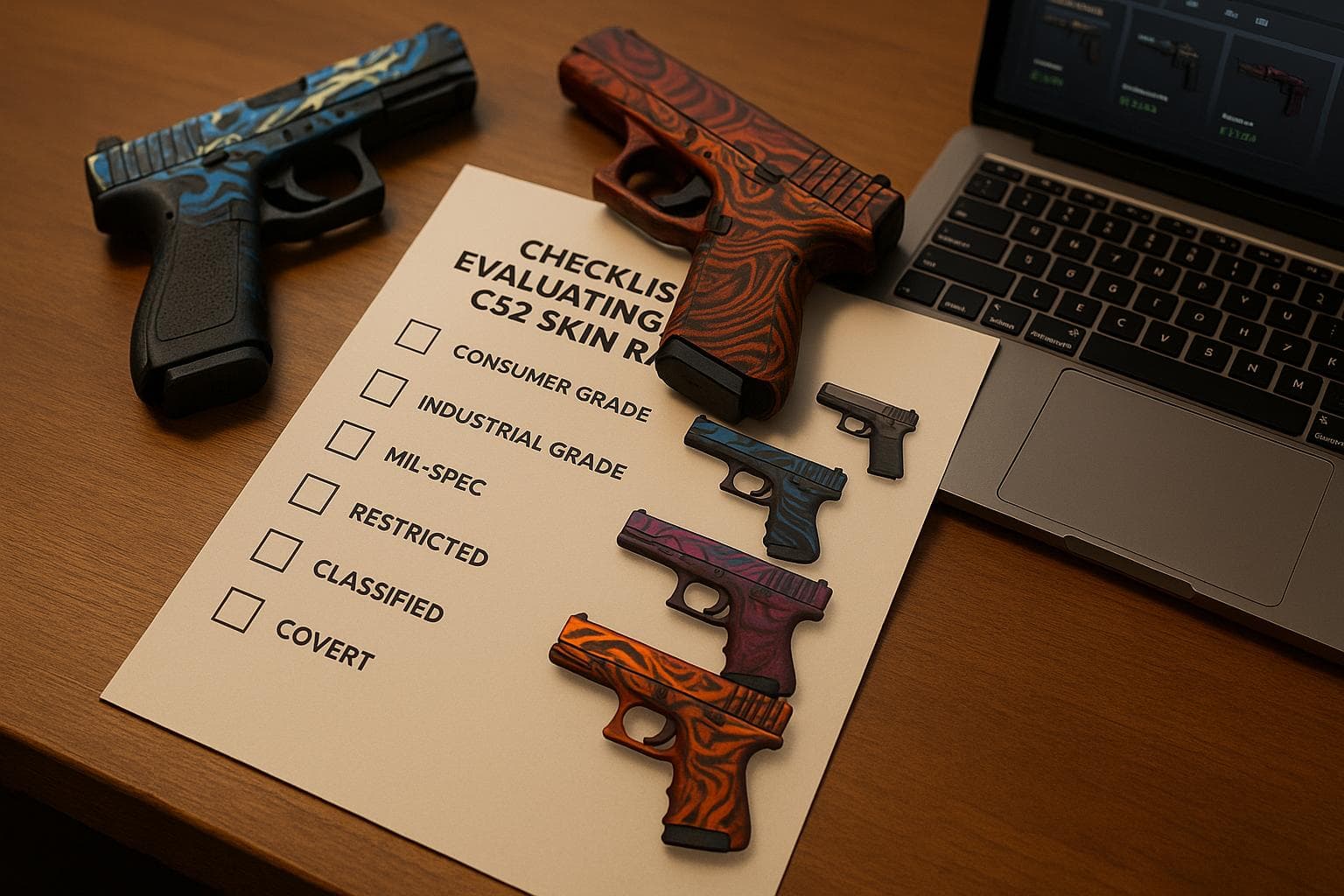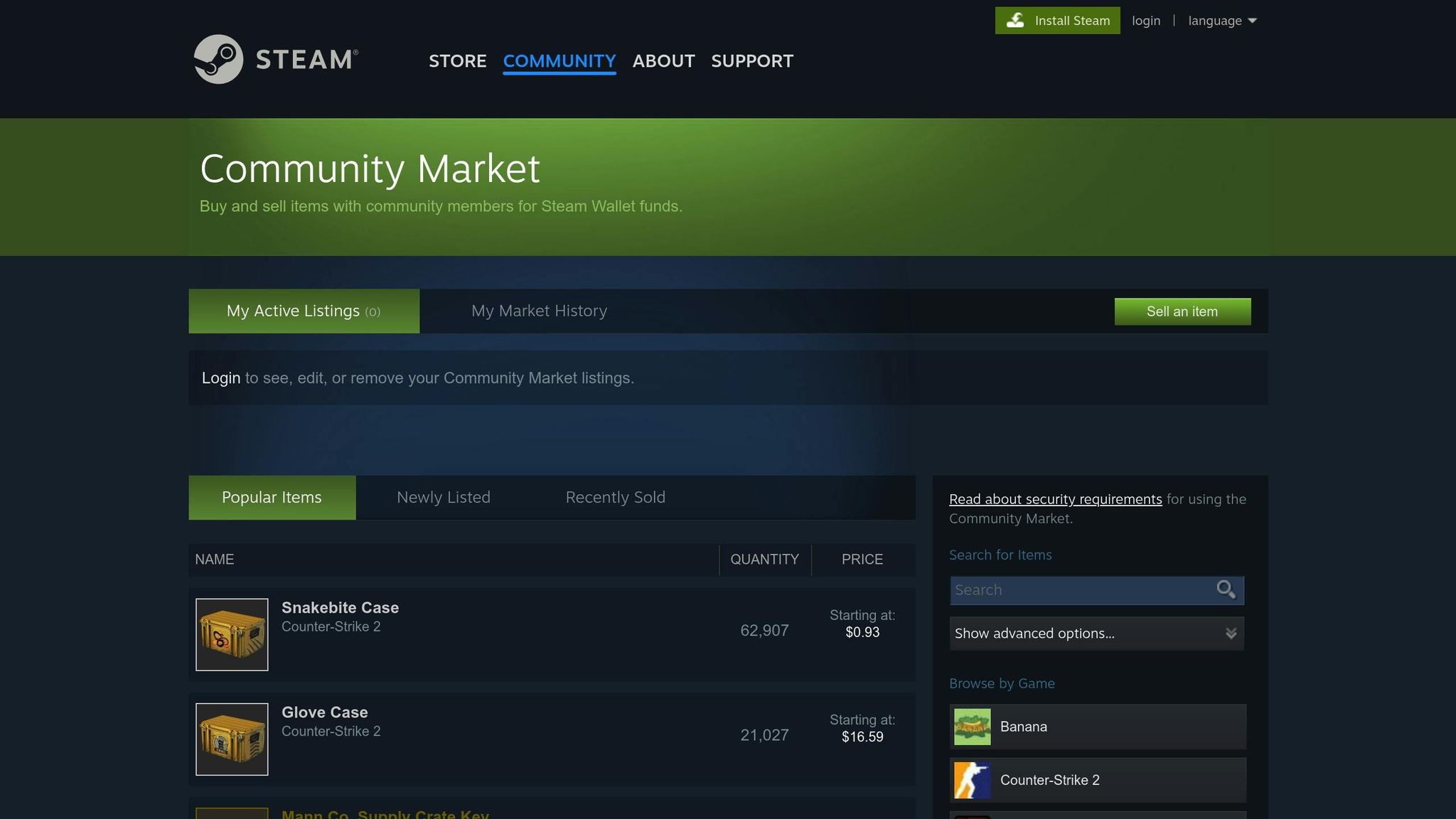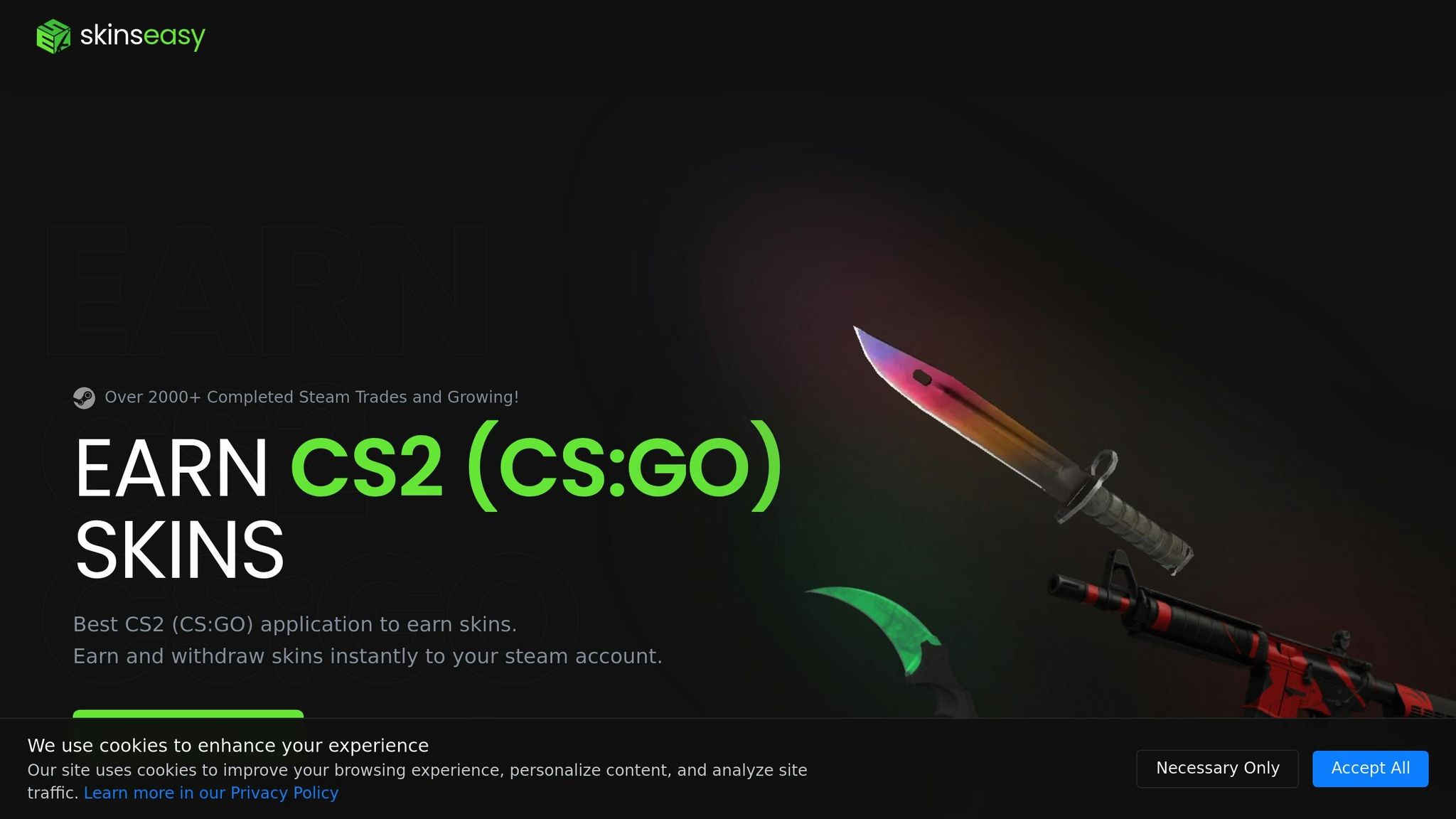Checklist for Evaluating CS2 Skin Rarity

Checklist for Evaluating CS2 Skin Rarity
When trading or purchasing CS2 skins, understanding what makes a skin rare can save you money and help you spot valuable items. Here's a quick breakdown:
- Rarity Tiers: Skins are categorized by color codes, from common (Consumer Grade) to ultra-rare (Exceedingly Rare/Gold). The rarer the tier, the higher the price.
- Wear Level: Skins have five wear levels (Factory New to Battle-Scarred). Lower float values within these levels often mean higher value.
- StatTrak: These skins track kills and are less common, often priced 2–3 times higher than standard versions.
- Stickers: Rare or tournament-related stickers can increase a skin's worth significantly.
- Limited Editions: Skins from exclusive collections or discontinued items are harder to find and more desirable.
To evaluate a skin, check its rarity tier, wear level, and any extras like StatTrak or stickers. Use tools like Steam Market or third-party platforms for accurate pricing and verification. Platforms like SkinsEasy also offer alternative ways to acquire skins through tasks and surveys. With these tips, you can make smarter trading decisions and build a collection with confidence.
CS2 Skins for Dummies: The ULTIMATE Guide
CS2 Skin Rarity Tiers Explained
CS2 uses a straightforward color-coded system to classify skins, linking their rarity to market value and trading potential.
Skin Rarity Categories
The system organizes skins into distinct tiers, each identified by a specific color in your inventory and on the Steam Market. Here's a breakdown of the categories:
- Consumer Grade (White/Grey): These are the most common skins with simple designs. They’re easy to get through gameplay or case openings.
- Industrial Grade (Light Blue): Slightly less common, featuring modest visual upgrades.
- Mil-Spec (Blue/Darker Blue): A balanced choice with detailed artwork, offering a mix of rarity and affordability.
- Restricted (Purple): Less common and more visually striking, often featuring complex patterns.
- Classified (Pink): These skins showcase detailed craftsmanship and command higher market prices.
- Covert (Red): Highly sought-after for their intricate designs and stunning visuals.
- Exceedingly Rare / Rare Special (Gold): Reserved for knives and gloves, these are at the top of the rarity spectrum. The odds of pulling a knife from a case are about 0.26% (roughly 1 in 384 tries).
- Contraband (Yellow/Orange): This ultra-rare tier includes only the M4A4 Howl, which was designated as Contraband after a copyright dispute led to its removal from circulation.
Here’s a quick summary of the tiers, their color codes, and their market impact:
| Rarity Tier | Color Code | Value | Frequency |
|---|---|---|---|
| Consumer Grade | White/Grey | Lowest | Most Common |
| Industrial Grade | Light Blue | Low | Common |
| Mil-Spec | Blue/Darker Blue | Moderate | Moderately Common |
| Restricted | Purple | Higher | Less Common |
| Classified | Pink | High | Rare |
| Covert | Red | Very High | Very Rare |
| Exceedingly Rare | Gold | Extremely High | Ultra Rare |
| Contraband | Yellow/Orange | Astronomical | Discontinued |
How Rarity Affects Market Value
The rarity tier plays a big role in determining a skin’s market value. Common tiers like Consumer Grade and Industrial Grade are usually very affordable, while Restricted and Classified skins fetch higher prices due to their lower drop rates and superior designs. Skins in the Covert and Exceedingly Rare tiers often come with hefty price tags because of their exclusivity and visual appeal.
Contraband items, like the M4A4 Howl, stand out as a category of their own. Their limited availability and unique status make them highly sought after, driving up their market demand and value.
Grasping these tiers can make it easier to evaluate a skin’s trading potential and appeal in the marketplace.
Skin Rarity Evaluation Checklist
When assessing the rarity of a CS2 skin, following a clear and systematic process can help you make informed trading decisions. By combining knowledge of rarity tiers with specific skin attributes, you can better understand a skin's exclusivity and potential market value.
Check the Rarity Tier and Color Code
Start by identifying the skin's official rarity tier using its color-coded border. You can find this in your inventory or on the Steam Market. These colors provide a quick visual cue about the skin's base rarity. For example, purple or red borders often indicate higher-tier items, which may fetch premium prices. Refer to the earlier table for details on how these color codes align with rarity levels.
Examine Wear Level and Float Value
The condition of a skin plays a major role in its appearance and market price. CS2 skins are classified into five wear levels:
- Factory New: Float values between 0.00 and 0.07
- Minimal Wear: Float values between 0.07 and 0.15
- Field-Tested: Float values between 0.15 and 0.38
- Well-Worn: Float values between 0.38 and 0.45
- Battle-Scarred: Float values between 0.45 and 1.00
Within each wear category, skins with lower float values (e.g., a 0.01 Factory New skin vs. a 0.06) tend to be more desirable and command higher prices.
Look for StatTrak Features
StatTrak skins are equipped with a kill counter that tracks confirmed kills made with a weapon, making them both functional and rare. These versions are less common than standard skins and are typically priced 2–3 times higher. The orange kill counter displayed on StatTrak skins adds a unique appeal, especially for players who value tracking their in-game achievements.
Check Applied Stickers
Stickers can add significant value to a skin, particularly if they are rare or from notable tournaments. The type, condition, and placement of stickers all influence a skin's worth. For instance, Katowice 2014 stickers, especially in pristine condition, can dramatically increase a skin's value. Similarly, stickers from major events like ESL One or DreamHack championships often carry a premium due to their limited production and collectible nature.
Confirm Limited Edition Status
Some skins are part of exclusive collections, which enhances their rarity and market appeal. To check if a skin is a limited edition, review its collection name on reliable skin databases or marketplaces. For example, the "Limited Edition Item" collection, introduced by Valve on October 2, 2024, includes only three skins: the Desert Eagle | Heat Treated, M4A1-S | Solitude, and XM1014 | Solitude. These skins were available for a short time, making them highly sought after as their supply diminishes. Limited edition skins often hold long-term value because of their exclusivity, making them standout items in the trading community.
sbb-itb-885d88f
Market Demand and Price Analysis
Getting a handle on market demand and price trends is key to making smarter trading choices.
Review Recent Sales Data
The Steam Market provides a handy sales history graph for every CS2 skin, displaying price trends in U.S. dollars. This graph reveals whether a skin's value is climbing, dropping, or staying steady. However, it doesn’t include finer details like specific float values or stickers. For a deeper dive into trading data, third-party tools come in handy.
Additionally, take a closer look at trade volumes and community interest to better understand the demand in the market.
Skin Verification Tools and Resources
Having the right tools at your fingertips makes it easier to verify a CS2 skin's rarity, float value, and market price before making a trade.
Steam Market Analysis

The Steam Community Market is your go-to source for official pricing and sales history. When listing a skin from your inventory, Steam automatically displays the current market prices for similar items.
Steam's data offers detailed insights, such as median sale prices and hourly trade volumes during peak periods. This information isn't just about understanding current prices - it also helps you spot trading patterns and market trends.
However, keep in mind that Steam applies a 15% fee to all skin sales, which will cut into your earnings. Always factor this fee into your calculations to get a clear picture of your potential returns.
For those who want more detailed metrics, third-party tools can provide additional layers of information.
Third-Party Verification Tools
Third-party platforms go beyond Steam's basic data, offering advanced features to help you assess skins more thoroughly. For instance:
- Tradeit.gg's CS2 Float Value Checker lets you check a skin's float value, paint seed, rarity tier, and item ID by simply pasting the inspect link. This tool works for any skin, whether it’s in your inventory or not.
- CSFloat's database tracks the total number of rare skins in existence. For example, they report that only 3,407 copies of the AWP Gungnir exist as of 2025. This kind of scarcity data gives you a clearer picture of a skin's rarity beyond just its color-coded tier.
- Pricempire provides insights into market capitalization and liquidity by analyzing trading volume and Steam data. As of February 18, 2025, they estimated the CS2 skin market cap at $4.1 billion, noting steady growth trends.
| Verification Method | Best For | Key Advantage |
|---|---|---|
| In-Game Inspection | Skins in your inventory | Most accurate float values |
| Third-Party Websites | Any skin via inspect link | Comprehensive data, including paint seed |
| Browser Extensions | Quick checks while browsing | Convenient integration with Steam |
These platforms typically offer lower fees and faster transactions compared to Steam's marketplace. They also provide features like auction systems, rarity filters, and real-time market analytics.
If you're looking for an alternative way to grow your collection, platforms like SkinsEasy offer unique options.
SkinsEasy for Earning and Trading

SkinsEasy provides a way to acquire CS2 skins without spending upfront. The platform operates on a "no deposits required" model, where users complete tasks, surveys, or quizzes related to CS2 to earn points. These points can then be exchanged for skins from their extensive inventory.
With thousands of secure Steam trades and a solid reputation for reliable skin delivery, SkinsEasy has become a trusted option for many users. The platform also offers up to 50% off deals compared to traditional marketplaces, making it a cost-effective choice for building your collection.
Additionally, SkinsEasy features a bidding system that allows users to compete for items within their point budget. Whether you're a new player looking to build an inventory or a seasoned trader hunting for specific items, SkinsEasy combines instant, secure transfers with competitive deals, making it a valuable tool for all types of CS2 enthusiasts.
Conclusion
Use this streamlined checklist to evaluate CS2 skin rarity effectively and make informed decisions. Here's a quick recap of the key factors to consider:
- Rarity Tier: Skins in higher tiers like Covert, Extraordinary, or Contraband can fetch prices in the thousands.
- Wear Level and Float Value: Lower float values, closer to Factory New, usually drive up prices. However, rare patterns can significantly boost value regardless of wear.
- StatTrak Features and Stickers: StatTrak skins and applied stickers, especially tournament-related or unique event items like the Souvenir Olof Scout, add exclusivity and can command premium prices.
- Limited Edition and Discontinued Collections: Skins from discontinued collections or limited releases are often more sought after, increasing their rarity and value.
Additionally, check recent sales data and trade volumes to assess current market demand. Reliable tools are essential for verifying float values and ensuring secure transactions. Platforms like SkinsEasy offer a safe way to grow your collection by completing tasks, playing games, and participating in surveys.
As CS2 skins evolve into sought-after digital collectibles, this checklist equips you with the knowledge to navigate the market confidently. Whether you're trading, collecting, or investing, these tips will help you make smarter choices.
FAQs
What is a CS2 skin's float value, and why is it important for its market value?
A CS2 skin's float value is a numerical indicator of its wear and condition, shown as a decimal ranging from 0 to 1. The closer the float value is to 0, the less wear the skin has, giving it a fresher and more polished appearance.
This value plays a key role in determining the skin's visual quality, rarity, and overall appeal, which can heavily influence its market price and trading potential. Knowing how float values work allows you to make smarter choices when it comes to buying, selling, or trading skins.
How can I check the rarity and authenticity of a CS2 skin before trading or buying?
To determine the rarity and authenticity of a CS2 skin, you can rely on trusted tools that offer in-depth insights into its history and market data. These tools help you verify key details like rarity, ownership records, and authenticity, giving you the confidence to make well-informed decisions before buying or trading.
When evaluating a skin, focus on critical factors such as its float value, pattern index, and market demand. These elements play a big role in determining both the rarity and overall value of a skin. Always stick to reputable platforms that specialize in CS2 skins to ensure the evaluation process is both accurate and secure.
How do stickers and StatTrak features affect the value of CS2 skins, and which stickers are the most valuable?
Stickers and the StatTrak feature play a big role in determining the value of CS2 skins. Rare stickers, especially those linked to iconic esports events like Katowice 2014, can dramatically increase a skin's price - sometimes by hundreds or even thousands of dollars. Among these, holo and foil stickers are highly prized. For instance, the Titan Holo from Katowice 2014 has been known to fetch over $100,000.
The StatTrak feature, which keeps a tally of in-game kills, adds another layer of appeal. Skins with StatTrak are particularly attractive to both collectors and players, boosting their market value. When evaluating a skin's rarity, it’s important to factor in the condition of the stickers and ensure the StatTrak counter is in working order.